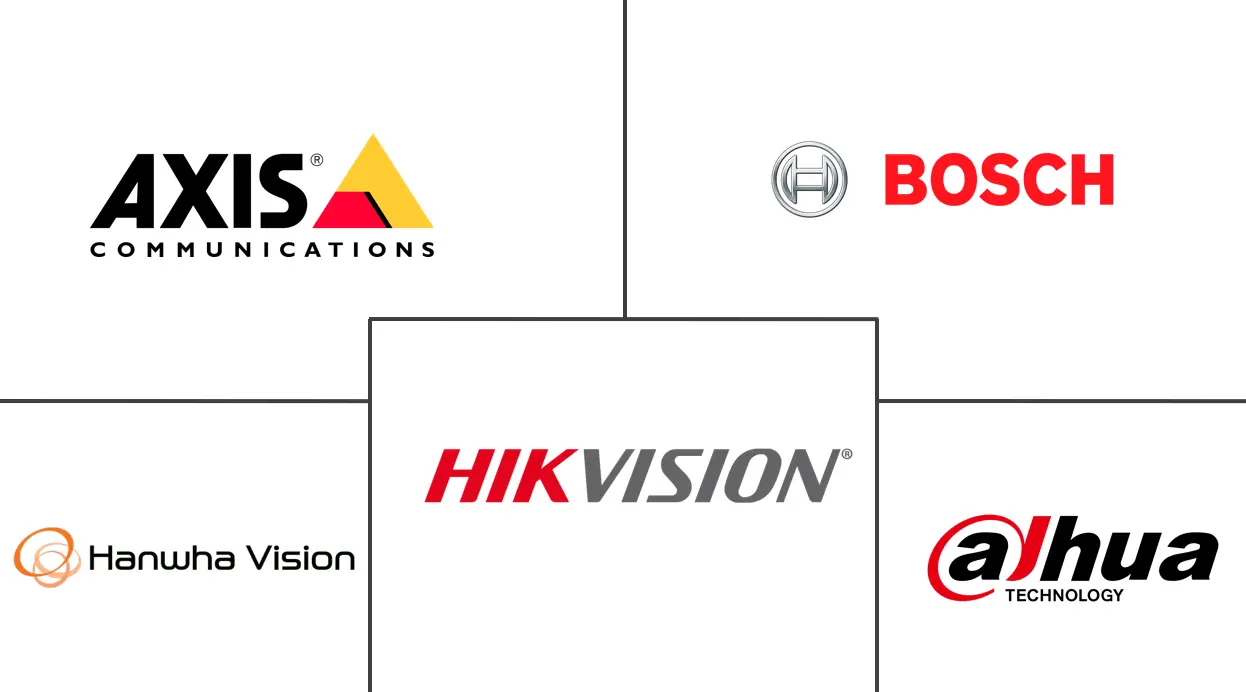Brazil Surveillance Camera Market Size and Share
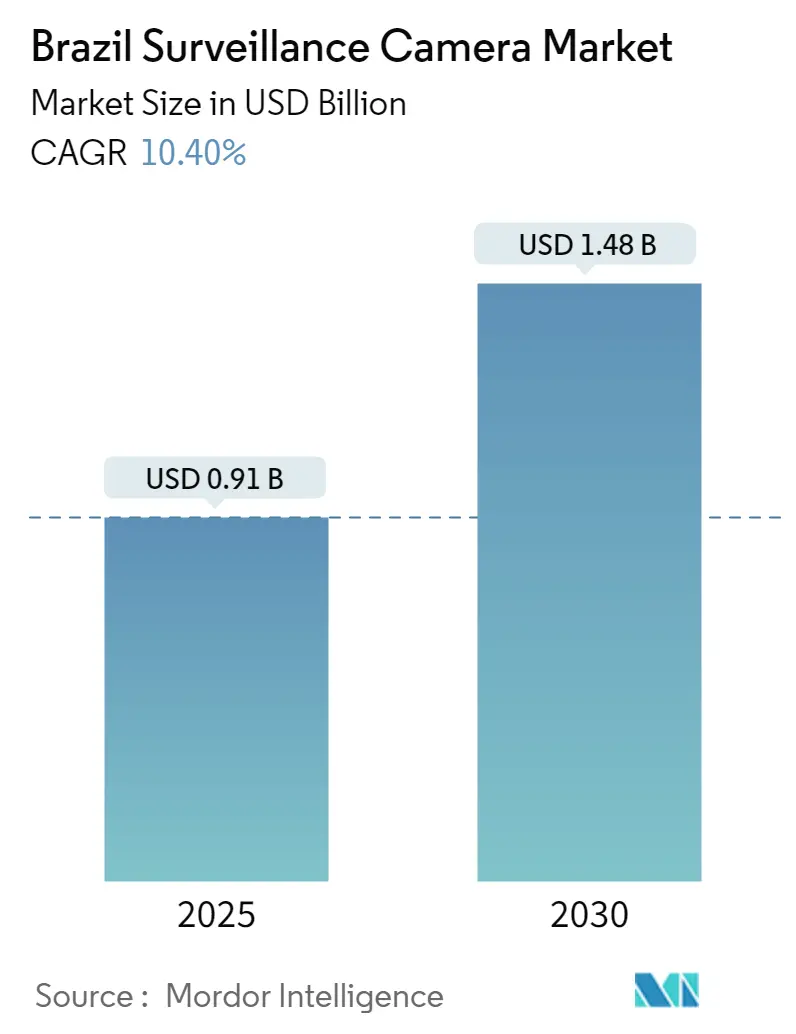
Brazil Surveillance Camera Market Analysis by Mordor Intelligence
The Brazil Surveillance Camera Market size is estimated at USD 0.91 billion in 2025, and is expected to reach USD 1.48 billion by 2030, at a CAGR of 10.4% during the forecast period (2025-2030).
- The Brazilian surveillance camera market is witnessing robust growth, primarily fueled by heightened security concerns. There's a pronounced shift towards advanced technologies and the integration of IoT in surveillance systems, with AI-driven analytics, facial recognition, and predictive analytics gaining traction.
- Brazil is channeling investments into smart city initiatives, embedding advanced surveillance systems for enhanced traffic oversight, crime deterrence, and public safety. Cities such as Sao Paulo and Rio de Janeiro lead these endeavors, bolstered by a partnership between the World Bank and the municipality, propelling Sao Paulo's evolution into a smarter city.
- Infrastructure investments by the government, covering transport, healthcare, and education, are driving the demand for sophisticated surveillance systems. In 2023, Brazil unveiled a USD 200 billion investment blueprint, targeting infrastructure, energy, and transportation over the next four years, in sync with its broader economic aspirations. Rising urbanization and crime rates in certain areas are key drivers behind the uptick in surveillance camera adoption.
- IP cameras are outpacing traditional analog models, thanks to their enhanced image quality, scalability, and integration ease. Commercial entities are increasingly adopting these advanced cameras, with industry leaders like Hikvision taking the lead, especially in expansive surveillance projects.
- As the retail and banking sectors expand, there's a heightened demand for advanced surveillance to deter theft, prevent fraud, and ensure customer safety. Concurrently, residential demand for surveillance cameras is surging, driven by growing home security concerns and the rise of home automation.
- Modern surveillance systems are often combined with access control, alarms, and other security technologies. A notable trend is the growing preference for cloud-based surveillance, which offers benefits like remote access, scalable storage, and cost savings. With the proliferation of connected devices, cybersecurity has become paramount, leading to substantial investments in measures to prevent data breaches and cyber threats.
- While the market grapples with challenges like economic fluctuations, privacy issues, regulatory barriers, and socio-political dynamics (especially political instability), the trajectory for smart technologies and public safety initiatives continues to ascend.
Brazil Surveillance Camera Market Trends and Insights
Technological Advancement & Rising Crime Rate to Drive the Demand
- Advanced technologies, particularly AI and IoT, are increasingly being adopted in the market. IP cameras, especially those with AI features like facial recognition and behavior analysis, are gaining traction. In Brazil, major cities such as Sao Paulo and Rio de Janeiro are leading the charge in smart city initiatives. These cities are utilizing IP cameras not just for traffic management but also for crime prevention, significantly boosting public safety.
- Given the market's optimistic trajectory, numerous vendors are keen on bolstering their foothold in the region. A case in point is Irisity, a Swedish software firm, which is amplifying its investments in Latin America. Irisity is strategically zeroing in on sectors like public security, transportation, and mission-critical infrastructure. With a specialization in AI and video analytics, Irisity's software adeptly addresses surveillance needs across diverse industries. Such movements are cultivating a conducive environment for the market's expansion in Brazil.
- Brazil's growing high-speed internet penetration is fueling the uptake of IP cameras, which rely on strong internet connectivity. The nation boasts over 180 million internet users, with access reaching more than 80% of its populace.
- There's a discernible pivot towards cloud-centric surveillance solutions. IP cameras with cloud integration offer benefits like remote access, expandable storage, and reduced infrastructure costs. With the rollout of 5G networks, companies are expected to boost investments in private mobile networks, addressing connectivity challenges and fulfilling operational needs.
- Furthermore, the market's expansion is underpinned by rising crime rates. For context, Brazil has consistently recorded over 40,000 homicides annually from 2020 to 2023, as highlighted by FBSP. This persistent crime rate, combined with growing security concerns in homes, businesses, and public areas, is set to amplify the demand for sophisticated surveillance systems. Additionally, there's a marked preference among consumers for high-definition and 4K video quality. The superior detail and clarity of IP cameras not only enhance their monitoring capabilities but also play a pivotal role in the market's growth.
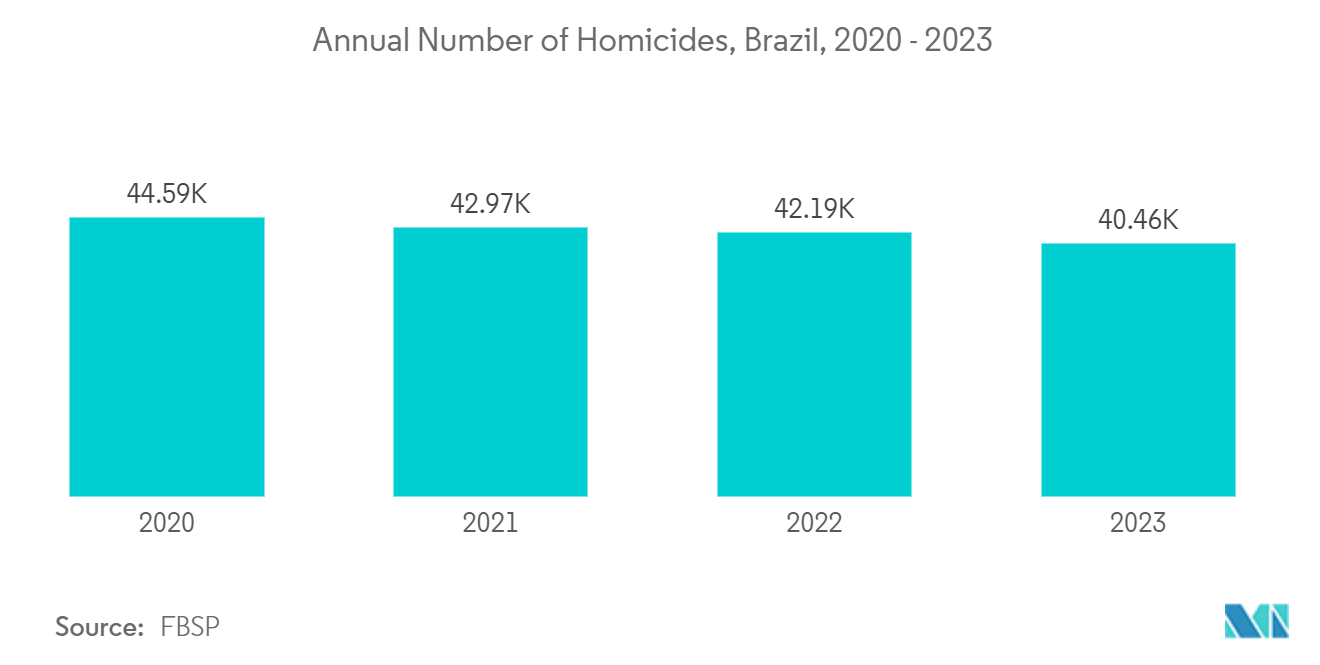
Government Segment to Hold a Significant Market Share
- To combat rising crime rates, the government is implementing robust public safety measures, harnessing state-of-the-art surveillance technologies. These measures include the installation of cameras in areas with high crime rates and within public transit systems. Major cities, including Sao Paulo and Rio de Janeiro, are leading the charge, deploying thousands of cameras and setting up sophisticated monitoring centers, which in turn boosts the demand for surveillance equipment.
- In 2023, Sao Paulo took a significant step by deploying 20,000 facial recognition cameras to bolster public safety. The government is also merging these surveillance systems with national security frameworks, aiming for a unified security approach. This strategy involves connecting city surveillance networks to national databases and collaborating closely with law enforcement.
- The nation is introducing facial recognition technology in its metro systems to bolster passenger safety. These systems are tied to a central control hub, enabling real-time monitoring of suspicious activities and swift alerts to security teams.
- The technology is multifaceted, covering object identification, tracking, and intrusion detection in restricted areas. It can spot unaccompanied minors, help find missing individuals, recognize unusual movements on platforms, and accurately count passengers—all while strictly adhering to Brazil's Data Protection Act.
- Government investments in public infrastructure are fueling a heightened demand for surveillance cameras. In 2023, public sector infrastructure investments reached USD 8.69 billion. This surge in demand is a direct consequence of the bolstered budget for public safety measures. These investments not only enhance public safety but also act as a robust economic stimulus, benefiting the market under study.
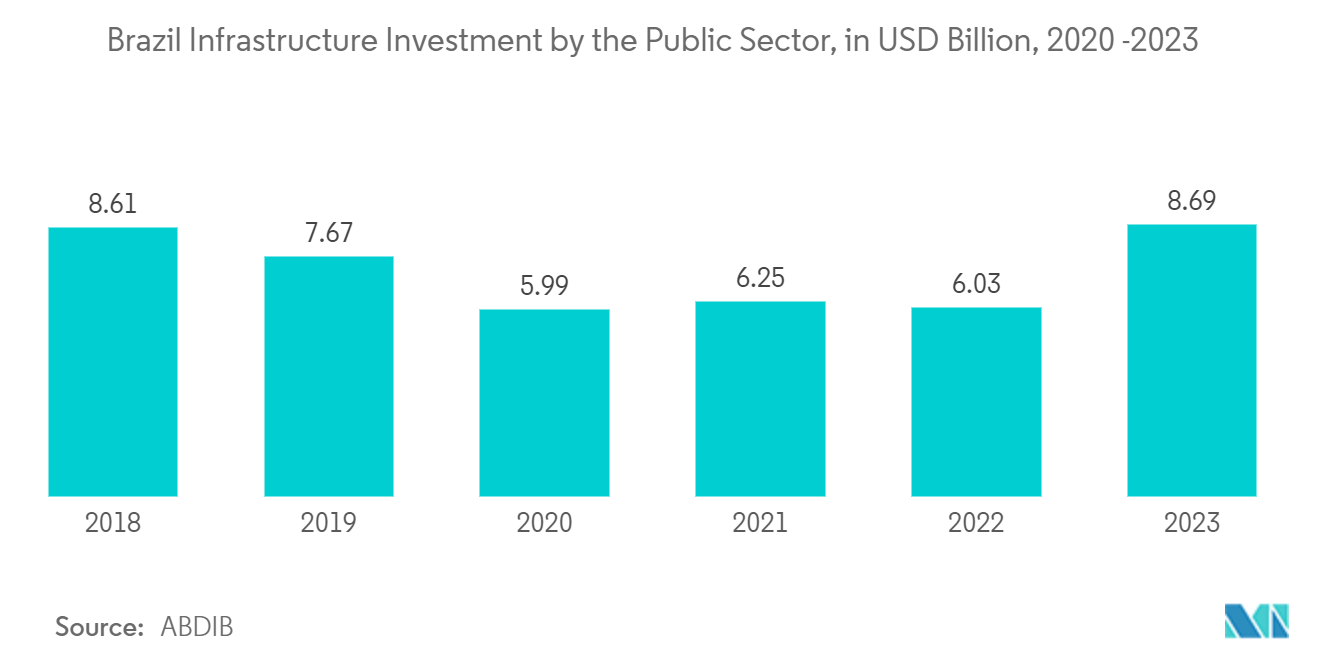
Competitive Landscape
Brazil's surveillance camera market is currently moderately competitive, but it's evolving towards a more fragmented landscape. Both major domestic and international players are vying for dominance by introducing technologically advanced products. The market boasts diverse manufacturers, all pushing the envelope with cutting-edge technologies and solutions. Notably, Chinese manufacturers stand out as formidable contenders, intensifying the competition.
A mix of global and domestic firms populate the market, each offering a spectrum of surveillance camera types, software solutions, and integration services. Key players making their mark include Bosch, Hikvision, Axis Communication, and Hanwha Vision, to name a few.
In Brazil, the demand for surveillance cameras is surging, driven by an escalating need for advanced security systems, a rise in criminal activities, and the evolution of residential infrastructure. Electronic surveillance systems, with their advantages over traditional physical security—most notably, the capability for remote and continuous monitoring—have seen widespread adoption across the nation. Consequently, market vendors should prioritize crafting innovative and cost-effective solutions, taking into account price sensitivity and the evolving preferences of consumers.
Brazil Surveillance Camera Industry Leaders
-
Zhejiang Dahua Technology Co., Ltd
-
Hangzhou Hikvision Digital Technology Co., Ltd.
-
Axis Communcation AB
-
Hanwha Vision America
-
Bosch Sicherheitssysteme GmbH
- *Disclaimer: Major Players sorted in no particular order
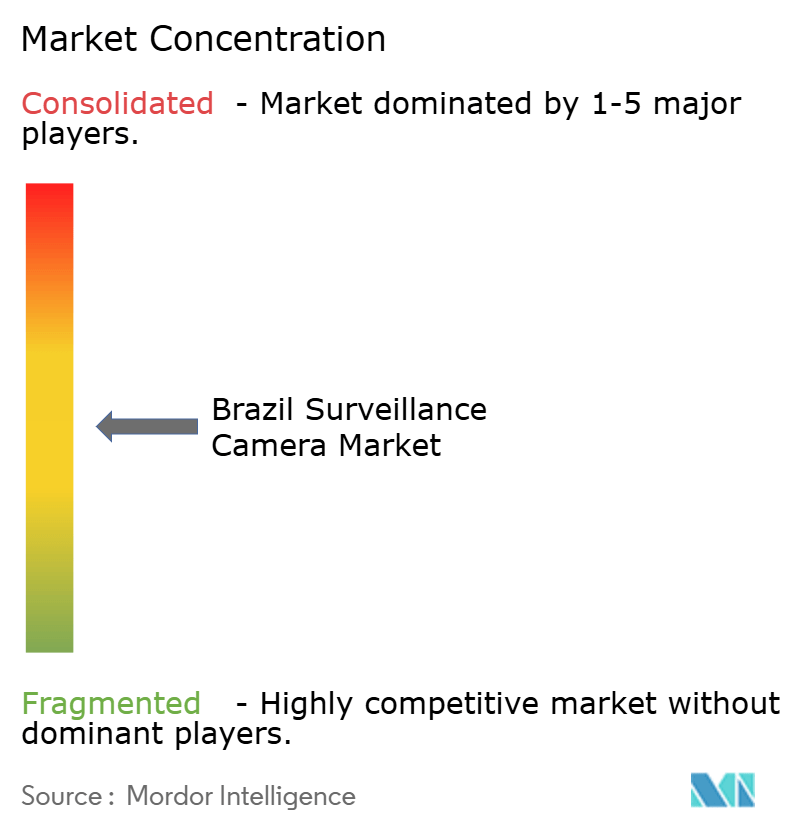
Recent Industry Developments
- May 2024: Bosch Security Systems, a key player in Brazil's surveillance camera market, has unveiled its latest offering: the FLEXIDOME 3100i camera. The company asserts that this new addition to the 3100i product family ensures robust security while upholding data integrity and advanced video analytics. Featuring a subtle design, the FLEXIDOME 3100i is perfectly suited for environments like office buildings, schools, and other venues where discreet surveillance is paramount.
- March 2024: RecFaces, a Dubai-based developer specializing in facial recognition solutions, has implemented its Id-Guard technology at the 2024 Brazil Carnival. Cameras equipped with this technology were strategically positioned at mobile control checkpoints. Utilizing real-time biometric identification, ID-Guard swiftly notified security personnel of any prohibited individuals present in the crowd. The success of these initiatives is expected to bolster the technological landscape of Brazil's surveillance camera market.
Brazil Surveillance Camera Market Report Scope
Surveillance cameras, commonly referred to as security cameras, are specialized video devices used to oversee designated areas. These cameras usually connect to either a recording system or an IP network, with monitoring being especially prevalent in commercial environments. This study delves into the trends and dynamics of various surveillance camera types across diverse end-user sectors in Brazil. For market estimation, the analysis is based on the sales data of leading surveillance camera vendors in Brazil.
The Brazilian surveillance camera market is segmented by type (analog-based and IP-based) and end-user industries (banking and financial institutions, transport and infrastructure, government and defense, healthcare, industrial, retail, enterprises, residential, others). The market sizes and forecasts are provided in terms of value (USD) for all the above segments.
| Analog-based |
| IP-based |
| Banking and Financial Institutions |
| Transportation and Infrastructure |
| Government and Defense |
| Healthcare |
| Industrial |
| Retail |
| Enterprises |
| Residential |
| Others |
| By Type | Analog-based |
| IP-based | |
| By End-user Industry | Banking and Financial Institutions |
| Transportation and Infrastructure | |
| Government and Defense | |
| Healthcare | |
| Industrial | |
| Retail | |
| Enterprises | |
| Residential | |
| Others |
Key Questions Answered in the Report
How big is the Brazil Surveillance Camera Market?
The Brazil Surveillance Camera Market size is expected to reach USD 0.91 billion in 2025 and grow at a CAGR of 10.40% to reach USD 1.48 billion by 2030.
What is the current Brazil Surveillance Camera Market size?
In 2025, the Brazil Surveillance Camera Market size is expected to reach USD 0.91 billion.
Who are the key players in Brazil Surveillance Camera Market?
Zhejiang Dahua Technology Co., Ltd, Hangzhou Hikvision Digital Technology Co., Ltd., Axis Communcation AB, Hanwha Vision America and Bosch Sicherheitssysteme GmbH are the major companies operating in the Brazil Surveillance Camera Market.
What years does this Brazil Surveillance Camera Market cover, and what was the market size in 2024?
In 2024, the Brazil Surveillance Camera Market size was estimated at USD 0.82 billion. The report covers the Brazil Surveillance Camera Market historical market size for years: 2019, 2020, 2021, 2022, 2023 and 2024. The report also forecasts the Brazil Surveillance Camera Market size for years: 2025, 2026, 2027, 2028, 2029 and 2030.
Page last updated on:
Brazil Surveillance Camera Market Report
Statistics for the 2025 Brazil Surveillance Camera market share, size and revenue growth rate, created by Mordor Intelligence™ Industry Reports. Brazil Surveillance Camera analysis includes a market forecast outlook for 2025 to 2030 and historical overview. Get a sample of this industry analysis as a free report PDF download.
